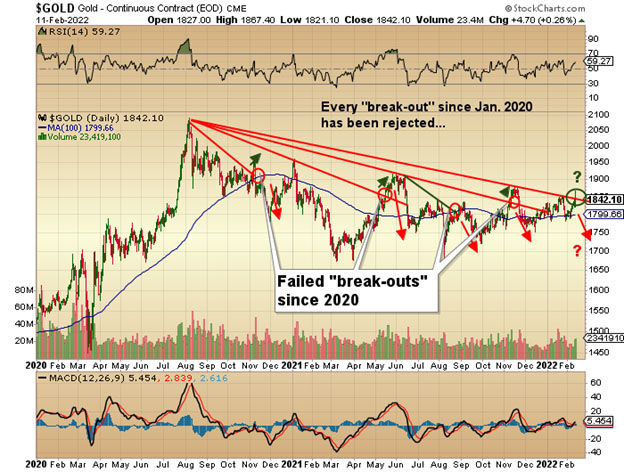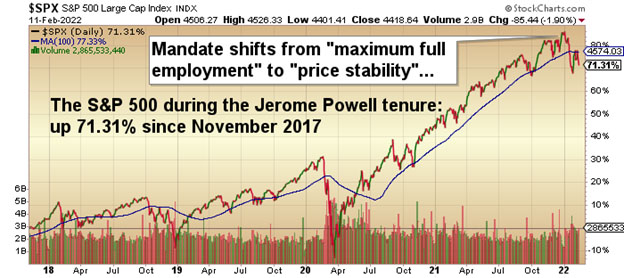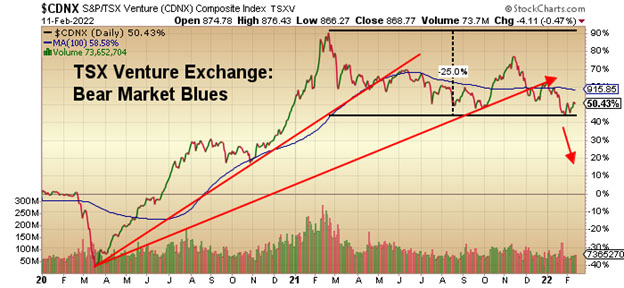
Before I expand upon the events of the past week that caught my increasingly illusory attention span, I wish to impart upon my readers one of the many chasms that separate the generational narratives these days. When I first entered the Hallowed Halls of Bay Street in 1977, I was trained by men and women that can only be described as “warriors” in the sense that they carried a code of conduct into battle each and every day. Notwithstanding the blue blazers and grey-flannel slacks accompanying the perfunctory buttoned-down dress shirt, there was never a day nor occasion, no matter how casual, that did not demand a jacket and tie.
As important as appearance was to the adherence to behavior, at no time did I ever hear a gentleman use profanity in any conversation in which he or she was representing his firm. Now, coming off a twenty-odd-year run as an aspiring professional hockey player, not only was the use of profanity a common form of descriptive enhancement to any and all locker room war stories, the use of the four-letter-word became an art form. The word was a noun, a verb, an adjective, and an adverb, all depending on context and very much required in the same way that bold or italics or underline accentuate words within a sentence. In fact, there were people from the remote regions of Kirkland Lake or Prince Albert or Dawson City that could not even begin to understand you unless you peppered the conversation with ample dollops of colloquialisms describing either body parts or bodily functions.
My roommate in university was from Valleyfield, Quebec, and it was he who taught me that in the Quebec patois, profanity is centered around the church with all cursing related to Catholicism or the defamation thereof, unlike the “heathens” from the rest of Canada who found great glee in “parts.”
However, I digress. Back in the day, rookies to the world of Bay Street finance had basically five place to seek employment and all of those firms had senior executives that went to essentially the same private schools and belonged to the same private clubs so despite the fact that there was fierce competition between Wood Gundy and McLeod Young & Weir for government bond business, you would never – and I mean NEVER – hear one bad word uttered by a Gundy person about McLeod or by a McLeod person about Gundy. “They are a fine firm” was always the party-line whether or not you saw the opponent scarfing scraps drunk at the back of Winston’s or dancing with a drag queen somewhere up on Jarvis St.
By always taking “The High Road,” new entrants to the fraternity of the Canadian Financial Establishment were trained to revere and respect the code of conduct that would sustain and protect an industry that financed such amazing enterprises as Blackberry (Research-in-Motion), Canadian Tire, and essentially every major discovery of resource in the Dominion of Canada since its inception in 1867. Now, make no mistake. It was done for one reason and one reason alone – greed – and while some would liberally apply lipstick, blush, and rouge to such a statement, and prefer to use the word “progress,” the hunt for wealth when I was a young and very active participant included a great many institutions and organizations from around the world but at no time was that industry ever subservient to nor dependent upon a single entity to the degree that it is today, and that entity is GOVERNMENT.
While people driven by either personal achievement measured by either accomplishment or wealth (or both) are usually fully aware of risk, government service entails zero risk. Sure, you have reputational risk but virtually no financial risk, and if you have no personal financial risk, then you make decisions that are rarely, if ever, “rules-based.” Assuming that one’s rules are grounded in the desire for positive economic outcome, if you are a government employee, your major priority lies in getting re-elected or re-appointed after which all other priorities lie in a subordinated pile of dormancy and procrastination. That is why the private sector, if left alone and unimpeded by political agendas, has proven over time that it can deliver positive economic outcomes far more reliably than government initiatives.
The big story that ended the week was a beautifully constructed rumor emanating from the Biden-Harris White House that Super Grandmaster Putin is planning a “bloody invasion” of the Ukraine by the middle of next week. This totally bizarre, planted story sent oil and gold soaring and stocks crashing within seconds of the release but if the White House has sent orders to Jerome Powell to “get inflation under control,” why on earth would they lay out such a yarn on a Friday afternoon after a week that had the 10-year yield surge above 2% and stocks resume their newly anointed downtrends with vigor?
As the chart at the start of this missive reveals, gold prices have punched out through no few than five major downtrend lines since the beginning of 2020 only to have four of them turn out to be fake-outs, with prices reversing back down and hitting new lows well below the break-out levels shortly thereafter. The fifth such break-out happened on Friday and while the jury is out, the reason for the sudden panic into oil and gold was all “event-driven” and in my forty-five-odd years of trading, the vast majority of event-driven moves turn out to be failures. You have all heard this phrase from me before but seminal moments in a young person’s career rarely go forgotten and, in my case, it was an old NYSE trader “Jimmy” who said to me (in response to my breathless excitement over a technical break-out in gold in 1980, “son, throw dem chawts in da gah-bage; in gold, you SELL breakouts!” He responded to my deeply intellectual question “…but WHY, Jimmy?” with the following, “In gold and silver, you sell breakouts and you buy break-downs for one simple reason – it’s $%$^ rigged.”
The Twitterverse must have had no fewer than fifty tweets light up with a near-ecclesiastic chorus of celebration highlighting this wondrous event and given that I am seriously long gold and copper with a certain Canadian gold developer as my largest holding, one might suppose that I would join the Kumbaya-line and pay homage to the precious metals gods that have finally seen the light. However, that would not be the case because the gray hairs predominating my chin are growing with annoying frequency each and every time the ”breakout buyers” get summarily pummelled. Ergo, I absolutely refuse to a) buy the breakout nor b) respond to anything “event-driven.”
Could the move in gold and oil have been the machinations of a large group of traders looking for an excuse to have commodities grab the mantle of popularity from the tech and meme names? Could it have been the beginning of the Millennial and GenXer migration away from crypto and tech and into commodities? The answer is “YES” to both with the word “possibly” added for caveat-emptor flavoring.
With due credit to Albert Einstein, I really do not wish to become the walking embodiment of his definition of “insanity” through behaviors repeated over and over only to experience the same painfully negative outcome. Now, do I want the metals to finally begin to respond with upside volume as have copper and gold and lumber (and everything else on the planet denominated in “fiat”)? Of course, I do, but I am not going to pin my last breath on it happening this time. The gold gurus would tell you that gold has its move only after the rate-hike cycle begins but that was not the case in 1979–1980, the last time the Fed went hostile. Traders using the post-GFC period as the sample range are ignoring data from the past forty years that shows a drop in gold under the Volcker Assault on Inflation from US$873 to under $350 in two years, with oil in the same period declining from US$40 to under $10.
To be sure, before I have to fend off the barrage of tweets and emails and text messages lecturing me as to why “it’s different this time,” you must first do a tap dance through the sands of time and realize that this term “stagflation” being bandied about by every “inflationista” from Brussels to Beijing think that the global inflation cycle is just about to drive us into stagflation but what is absent from the debate is that we are already well through the inflation cycle. The biggest moves in commodities came BEFORE the appointment of Paul Volcker in 1979 during the tenure of Arthur Burns who yielded to Nixonian pressure and refused to alter policy initiatives until gas lines and 12% CPI increases threatened the Nixon re-election efforts.
Under Jerome Powell and his “maximum full employment” mandate, which began in 2017, the S&P has advanced over 70% as Powell and his fellow academics at the Fed experimentation laboratory seized upon the asymmetrical wealth effect of rising stock prices as a panacea for unemployment. With the shift in mandate to “price stability” in late 2021, the table was set for an abandonment of those conditions that created a perennial “Buy the Dip” psycho-response to any and all corrective behaviors, which, I might add, played out chapter and verse in January. Alas, the “dippers,” who chased the S&P right up to the exact point where the Fibonacci retracement level threw up a cast-iron ceiling of supply, are now largely underwater.
For old war horses like me, it is like watching a beer bottle slowly slide of the edge of a table; it is like time stops and not even lightning reflexes can prevent one’s fascination with the morbidity of shattering and splattering glass and suds. Behaviors perfected during a “friendly-Fed” regime must be un-perfected and un-learned. As I wrote about in the 2022 Forecast Issue, the dominant theme for the year is no longer inflation-hedging; it has morphed into preservation of capital and defense against massive increases in volatility.

This brings me around to a discussion point of utmost importance, now that the evidence is pointing to one very sobering reality: the global markets, now approaching correction mode, have possibly (probably?) entered into a secular bear market.
To wit, since only a handful of stocks were elevating the major averages like the S&P, the NASDAQ is in full-bore correction mode, down over 15% but, and I utter this with great regret, the TSX Venture Exchange, the card-carrying poster child for inflation speculation due to its predominant role as an incubator for junior resource issues including many highly speculative exploration companies, has now entered into a rather nasty bear market with a 25% drawdown from the February 2021 peak. The February top was the pinnacle for the “deteriorating supply chain” narrative where everyone and their crypto-enriched, obnoxious brothers-in-law were scrambling for silver and gold stocks in order to benefit from the inflationary impacts of diminished supply. I liken one year ago to 1980, when John Q. Public first learned about the inflation-resistance qualities of gold (at USD $800 per ounce) and were lined up outside Scotia Mocatta with their baby-sitting money ready to pounce upon every wafer and coin that glistened every time they lit a smoke.

The Encyclopedia of Brilliant Investing would tell you that owning only “asymmetrical” stories immune from the influences of central bankers and politicians like uranium and copper will insulate you and allow the pure forces of accelerating demand and limited supply to propel you to financial Nirvana. However, as much as the 1970s were the decade of gold and oil riches, there was a period in 1975–1976 where gold and oil corrected leaving the investor out on a limb until eventually the money printing financing the Vietnam War ultimately drove everything into the clouds. As “asymmetrical” uranium might appear, it might have been immune from central bank policy moves but it has not been immune from greed, with many of the uranium darlings down over 50% from the 2021 highs.
Copper was absolutely screaming this week, that is, until Friday, when a 4.68% crash eliminated all gains and wound with a big red weekly candle. It would not have been so bad had it not printed over $4.70/lb on Thursday, because the technical picture just went from “New highs here we come!” to “Uh-oh,” and that is because weekly reversals like that are not only bearish on a short-term basis, but they do also not bode poorly for the overall commodities narrative. Dr. Copper is an important general in the battle for commodity dominance in today’s markets. Without it, all other aspects of bullish commentary become suspect.
When bear markets arrive, it is always the more speculative sectors that get whacked first and hardest. What is troubling about the TSX Venture Exchange is that not even junior oil exposure could propel it to a gain on Friday, and with oil above $94/bbl, one might have expected strength.
The coming week will be interesting in the sense that as is the case with all “event-driven” moves, if the predicted event fails to arrive, there will be an immediate and painful downside reaction and in the context of a bear market in the TSXV and a steepening correction in the NASDAQ, portfolios that have our mandated 15% allocation to volatility should be able to weather the storm. Our UVXY:US trade is now ahead 34% YTD but that figure is meaningless in the context of portfolio protection. Not that I am predicting a repeat of March 2020, but UVXY:US advanced 750% in eight weeks back then and over the past five years, it has proven to be effective, on occasion, in hedging portfolios against big drawdowns. I like it here in 2022 for all of the reasons mentioned earlier and for reasons yet unknown that will most certainly force locks on liquor cabinets and medicine chests to be pried off before the bull returns…
As they say in Timmins, caveat *$%^ emptor.
Originally published Feb. 11, 2022.
Follow Michael Ballanger on Twitter @MiningJunkie. He is the Editor and Publisher of The GGM Advisory Service and can be contacted at [email protected] for subscription information.
Originally trained during the inflationary 1970s, Michael Ballanger is a graduate of Saint Louis University where he earned a Bachelor of Science in finance and a Bachelor of Art in marketing before completing post-graduate work at the Wharton School of Finance. With more than 30 years of experience as a junior mining and exploration specialist, as well as a solid background in corporate finance, Ballanger's adherence to the concept of "Hard Assets" allows him to focus the practice on selecting opportunities in the global resource sector with emphasis on the precious metals exploration and development sector. Ballanger takes great pleasure in visiting mineral properties around the globe in the never-ending hunt for early-stage opportunities.
Disclosure:
1) Statements and opinions expressed are the opinions of Michael Ballanger and not of Streetwise Reports or its officers. Michael Ballanger is wholly responsible for the validity of the statements. Streetwise Reports was not involved in any aspect of the article preparation. Michael Ballanger was not paid by Streetwise Reports LLC for this article. Streetwise Reports was not paid by the author to publish or syndicate this article.
2) This article does not constitute investment advice. Each reader is encouraged to consult with his or her individual financial professional and any action a reader takes as a result of information presented here is his or her own responsibility. By opening this page, each reader accepts and agrees to Streetwise Reports' terms of use and full legal disclaimer. This article is not a solicitation for investment. Streetwise Reports does not render general or specific investment advice and the information on Streetwise Reports should not be considered a recommendation to buy or sell any security. Streetwise Reports does not endorse or recommend the business, products, services or securities of any company mentioned on Streetwise Reports.
3) From time to time, Streetwise Reports LLC and its directors, officers, employees or members of their families, as well as persons interviewed for articles and interviews on the site, may have a long or short position in securities mentioned. Directors, officers, employees or members of their immediate families are prohibited from making purchases and/or sales of those securities in the open market or otherwise from the time of the decision to publish an article until three business days after the publication of the article. The foregoing prohibition does not apply to articles that in substance only restate previously published company releases.
Michael Ballanger Disclaimer:
This letter makes no guarantee or warranty on the accuracy or completeness of the data provided. Nothing contained herein is intended or shall be deemed to be investment advice, implied or otherwise. This letter represents my views and replicates trades that I am making but nothing more than that. Always consult your registered advisor to assist you with your investments. I accept no liability for any loss arising from the use of the data contained on this letter. Options and junior mining stocks contain a high level of risk that may result in the loss of part or all invested capital and therefore are suitable for experienced and professional investors and traders only. One should be familiar with the risks involved in junior mining and options trading and we recommend consulting a financial adviser if you feel you do not understand the risks involved.

























































